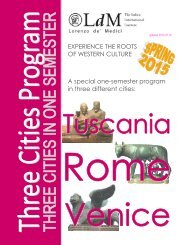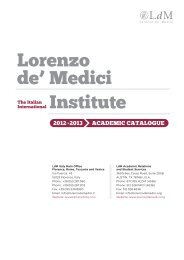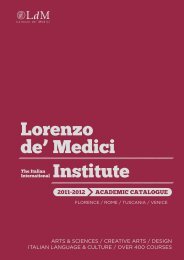aCademiC Catalog 2013-2014 - Lorenzo de Medici
aCademiC Catalog 2013-2014 - Lorenzo de Medici
aCademiC Catalog 2013-2014 - Lorenzo de Medici
Create successful ePaper yourself
Turn your PDF publications into a flip-book with our unique Google optimized e-Paper software.
chapters of the Iliad and the Odyssey, stu<strong>de</strong>nts will get in<br />
contact with the aristocratic world and heroes <strong>de</strong>scribed by<br />
Homer in 8-7th century BCE, in or<strong>de</strong>r to reconstruct the society<br />
of early Greece in the Mycenaean period. The stories presented<br />
in the Iliad and Odyssey, consi<strong>de</strong>red the “Bible” of classical<br />
civilization, show how Greeks used myth to express archetypal<br />
values which became immortal for successive generations.<br />
Myths are analyzed not only as amazing stories but also as<br />
bearers of important messages about life within society, and<br />
as primary forms of communication and instruction in a nonliterate<br />
and oral society. The great influence of Greek myths on<br />
Roman legends will also be seen through the reading of some<br />
passages of the Aeneid - the national poem of Rome written<br />
by Virgil in the 1st century BCE - focusing on the link between<br />
Roman history and Greek tradition. The hero of the work,<br />
Aeneas, was the survivor of the fall of Troy and the ancestor of<br />
Rome’s lea<strong>de</strong>rs. A comparison between Aeneas’ and Odysseus’<br />
wan<strong>de</strong>rings will conclu<strong>de</strong> the course.<br />
Greek and Roman Mythology<br />
CLA 310 T<br />
Cr: 3; Contact hrs: 45<br />
The traditional stories about the Greek gods and heroes have<br />
always been a fundamental part of Western art and literature,<br />
especially since their “rediscovery” by Renaissance humanism.<br />
A selection of the great works of ancient Greek literature will<br />
present the most important stories, and will also show how the<br />
Greeks used myth to express the traditional i<strong>de</strong>als and personal<br />
reflections that captivated and shaped subsequent European<br />
culture. The pictorial narratives, so common in Greek and Roman<br />
monuments and objects, will introduce the sophisticated visual<br />
language created by the Greeks to tell such elaborate tales,<br />
the first such iconographic system and one which was to some<br />
extent “revived”, together with the gods, heroes and heroines,<br />
in Renaissance art. To know Roman mythology and un<strong>de</strong>rstand<br />
its similarities and differences with Greek mythology is to<br />
un<strong>de</strong>rstand the real essence of the i<strong>de</strong>als and aspirations of a<br />
great people that built a great empire. In particular, Virgil and<br />
Ovid, the most wi<strong>de</strong>ly known writers of Roman mythology, and<br />
also other Roman writers, will help stu<strong>de</strong>nts <strong>de</strong>velop a new<br />
interest for Roman myth, history and art.<br />
History<br />
Western Civilization<br />
HIS 130 T<br />
Cr: 3; Contact hrs: 45<br />
Survey of cultural, social and political <strong>de</strong>velopments in the<br />
western tradition between its origins in the Ancient Near East<br />
and the present. Themes inclu<strong>de</strong>: the Ju<strong>de</strong>o-Christian and Greco-<br />
Roman heritages, medieval to mo<strong>de</strong>rn Europe, nationalism,<br />
industrialization, western imperialism, totalitarianism and<br />
two World Wars, challenges of the later 20th and early 21st<br />
centuries.<br />
Medieval Civilization and Culture<br />
HIS 212 T<br />
Cr: 3; Contact hrs: 45<br />
This course explores the remarkable series of transitions<br />
that Western civilization un<strong>de</strong>rwent between the years 313<br />
and 1400 CE, dates corresponding to Emperor Constantine’s<br />
official acceptance of Christianity, and the imposition of<br />
humanistic culture. In culture, politics and society, this long<br />
period witnessed a reorientation of values and enormous<br />
shifts in the configuration of Europe. In the visual arts,<br />
efforts to interpret classical artistic language were flanked<br />
by innovative contributions from different cultures. As<br />
stu<strong>de</strong>nts study historical and literary sources, archaeology as<br />
well as architecture, sculpture and painting, they acquire a<br />
chronological map of the essential <strong>de</strong>velopments, learning to<br />
distinguish between eras, and to interrelate political, social,<br />
economic and cultural trends. Rejecting the popular notion of<br />
a “dark age” of culture in the Middle Ages, we shall emphasize<br />
the concept of historic evolution. Topics inclu<strong>de</strong>: the Late<br />
Roman Empire, the Barbarian invasions, monasticism, medieval<br />
Christianity, the Crusa<strong>de</strong>s, the rise of the Italian city-states, the<br />
Black Death, and the roots of the Renaissance; Early Christian,<br />
Carolingian, Ottonian, Byzantine, Romanesque and Gothic Art.<br />
Italian <strong>de</strong>velopments and monuments receive special attention,<br />
and site visits in Tuscania, neighboring towns (such as Viterbo,<br />
Bolsena, Orvieto), and Rome, form an essential component of<br />
the course.<br />
The Age of Geographical Discovery<br />
HIS 270 T<br />
Cr: 3; Contact hrs: 45<br />
This course explores the relationship between various<br />
perceptions of physical reality experienced as a result of<br />
geographical inquiry, from the ancient Greeks to the eighteenth<br />
century, with particular focus on the Renaissance. Using travel<br />
journals and maps, the course investigates the ways in which<br />
geographical discoveries had an impact on how the world,<br />
and man’s place within it, was perceived. It thus examines the<br />
causes and consequences of geographical discovery through<br />
the evolution of text and image, within a context of myths<br />
and legends and real accounts and experiences. Tuscania will<br />
provi<strong>de</strong> a living example of the relationship between reality and<br />
imagination, through a tour of the city where the method of<br />
observation, <strong>de</strong>scription and interpretation will be applied.<br />
Archaeology Field School: Tuscania (Italy)<br />
HIS 282-283 T; Dual listed: ANT 282-283 T / CLA 282-283 T<br />
Cr: 6; Contact hrs: 148<br />
This four-week intensive course in archaeology is held at a<br />
specific site representing a distinctive ancient Mediterranean<br />
culture. The course offers stu<strong>de</strong>nts a unique combination<br />
of supervised on-site fieldwork and specialized aca<strong>de</strong>mic<br />
instruction by archaeologists and other specialists. Participants<br />
contribute to the ongoing excavation and preservation of the<br />
site, learning essential practical archaeological techniques. The<br />
particular civilization represented by the site is analyzed in terms<br />
of its material culture, artistic production, and society (including<br />
political organization, religion, economy, and everyday life). The<br />
course inclu<strong>de</strong>s weekly visits to sites, monuments and museums<br />
of relevance. Participants work alongsi<strong>de</strong> stu<strong>de</strong>nts from the<br />
University of Florence. The course is offered in collaboration<br />
with the Center for Ancient Mediterranean and Near Eastern<br />
Studies (CAMNES). Offered at various sites, including two<br />
sponsored by the <strong>Lorenzo</strong> <strong>de</strong>’ <strong>Medici</strong> Institute. One of the<br />
richest sites for Etruscan culture, Tuscania in northern Latium<br />
is situated in the southern area of the region inhabited by this<br />
people between the 9th to the 1st centuries BCE. Many features<br />
of the site and the wi<strong>de</strong> range of artefacts discovered belong to<br />
later Etruscan culture (Hellenistic period). The course focuses<br />
on Etruscan culture in a period of cosmopolitan expansion and<br />
assimilation to Roman culture. Learning activities may inclu<strong>de</strong><br />
visits to Cerveteri, Tarquinia, and the Museo di Villa Giulia in<br />
Rome. Excavation has been overseen by the University of<br />
Florence, <strong>Lorenzo</strong> <strong>de</strong>’ <strong>Medici</strong> Institute, and CAMNES.<br />
Note: HIS 282 T / ANT 282 T / CLA 282 T is offered also as a<br />
3-Credit (two week) Field School<br />
Ancient Mediterranean Civilization<br />
HIS 294 T; Dual listed: CLA 294 T<br />
Cr: 3; Contact hrs: 45<br />
This course presents a survey of the extraordinarily rich<br />
civilizations that thrived in Italy and the Mediterranean from the<br />
8th century BCE to the 5th century CE. Stu<strong>de</strong>nts investigate<br />
the political, social, cultural and religious dimensions of the<br />
Greek, Roman and Etruscan civilizations, engaging with<br />
surviving literature, art and architecture. Themes covered<br />
may inclu<strong>de</strong>: the principal historical <strong>de</strong>velopments; political<br />
trends in the Mediterranean world; classical literature;<br />
major issues in philosophy; spirituality and cults; cultural<br />
and commercial exchange in the Mediterranean. Site visits<br />
enhance un<strong>de</strong>rstanding of the chronology and the enduring<br />
achievements of ancient Mediterranean culture.<br />
Mo<strong>de</strong>rn Italy<br />
HIS 296 T; Dual listed: POL 296 T<br />
Cr: 3; Contact hrs: 45<br />
The main goal of the course is for stu<strong>de</strong>nts to gain a general<br />
un<strong>de</strong>rstanding of the way Italian history and culture has<br />
<strong>de</strong>veloped in the last 50 years, especially in the arena of<br />
public policies and social interactions. The course will be<br />
loosely divi<strong>de</strong>d in three main segments. The first one, relying<br />
School of Arts & Sciences TUSCANIA<br />
LdM Aca<strong>de</strong>mic <strong>Catalog</strong> <strong>2013</strong>-<strong>2014</strong><br />
161





